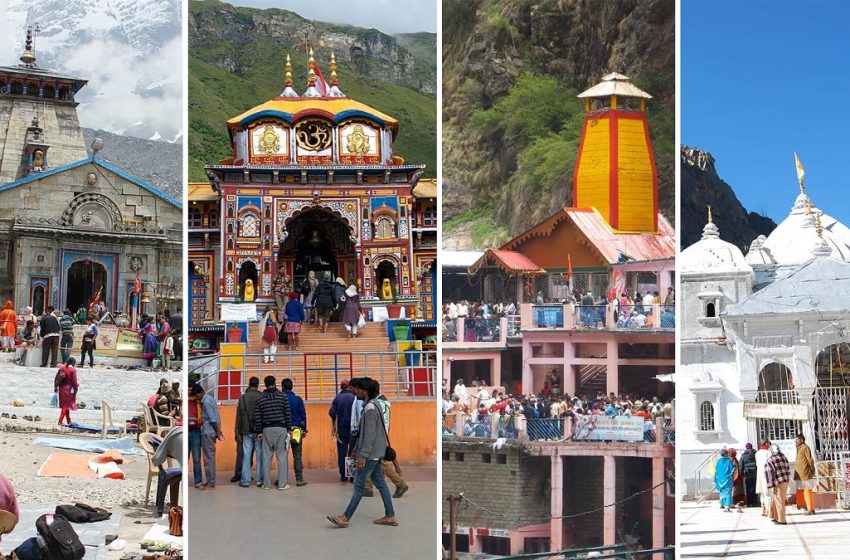The Sacred Path Embarking on the Char Dham Yatra in the Himalayas

The Char Dham Yatra, one of the most revered pilgrimages in Hinduism, stands as a symbolic journey of spiritual cleansing and personal transformation. Situated in the majestic Himalayas, this pilgrimage includes visits to four sacred temples: Yamunotri, Gangotri, Kedarnath, and Badrinath. Each of these holy sites holds deep spiritual and mythological significance, making the yatra not just a physical journey through rugged terrains but a profound inner exploration.
For centuries, millions of devotees have undertaken this pilgrimage with the belief that visiting these sacred abodes will purify them from sins, guide them closer to moksha (liberation), and ensure divine blessings for themselves and their families.
The Spiritual Significance of Char Dham
The Char Dham Yatra is deeply rooted in Hindu mythology, and each temple represents different deities and facets of the human journey. According to legend, visiting all four temples during one’s lifetime ensures spiritual liberation. These four locations symbolize life’s spiritual stages: from creation and preservation to destruction and liberation.
The journey begins at Yamunotri, followed by Gangotri, Kedarnath, and ends at Badrinath. Undertaking this journey in the prescribed sequence is believed to enhance the spiritual benefits.
Exploring the Four Sacred Sites
1. Yamunotri: The Beginning of the Divine Journey
Yamunotri, the first stop on the Char Dham Yatra, is located at an altitude of approximately 3,291 meters. This sacred place is dedicated to Goddess Yamuna, and it is believed that bathing in the holy waters of the Yamuna River at Yamunotri protects devotees from untimely death. The icy waters of the Yamuna are also thought to cleanse both body and soul, offering purification from worldly impurities.
- Highlight: The Yamunotri Temple, nestled amidst snow-capped peaks, is the starting point for pilgrims. Nearby, the Surya Kund, a hot spring, is another unique feature where pilgrims cook rice as an offering to the deity.
2. Gangotri: The Source of the Sacred Ganga
Gangotri is the birthplace of the River Ganga, which holds a special place in Hindu belief. Located at an altitude of 3,100 meters, Gangotri is where the river descends from the Himalayas, brought to Earth by King Bhagiratha’s penance. The Ganga is revered as the divine mother, and it is believed that bathing in the river washes away sins and purifies the soul.
- Highlight: The Gangotri Temple, situated near the river, offers a serene place of worship. Pilgrims also visit Gaumukh, the actual source of the Ganga, located further up in the glacier. The temple and the river both embody the deep spiritual cleansing associated with Ganga’s waters.
3. Kedarnath: The Spiritual Power of Lord Shiva
Kedarnath, located at an altitude of 3,583 meters, is dedicated to Lord Shiva, one of the most powerful deities in Hinduism. It is one of the twelve Jyotirlingas, making it a vital pilgrimage site for Shiva devotees. The temple is set amidst dramatic landscapes, surrounded by snow-capped peaks and the flowing Mandakini River. According to mythology, Lord Shiva eluded the Pandavas here by taking the form of a bull.
Kedarnath’s remote location requires a strenuous trek, adding to the spiritual merit of the journey. Despite modern helicopter services, many pilgrims still prefer to walk the 16 km route, seeing it as a test of their devotion.
- Highlight: The Kedarnath Temple, believed to have been originally built by the Pandavas, is a center of Shiva worship. Nearby, the Samadhi of Adi Shankaracharya, who revived Hinduism in the 8th century, is another important site.
4. Badrinath: The Final Step Towards Salvation
The final stop on the Char Dham circuit is Badrinath, located at 3,300 meters above sea level. The Badrinath Temple is dedicated to Lord Vishnu, who is worshipped here in his form as Badrinarayan. According to legend, Vishnu meditated here under the shelter of a Badri tree for thousands of years. The temple is a symbol of salvation and divine knowledge, making it the ultimate goal for pilgrims seeking spiritual fulfillment.
- Highlight: The Badrinath Temple, with its striking architecture and serene location near the Alaknanda River, is a magnet for pilgrims. The Tapt Kund, a natural hot spring, is where devotees bathe before entering the temple to cleanse themselves.
The Char Dham Yatra Experience
The Char Dham Yatra is not only a spiritual journey but also a test of endurance and willpower. The high altitudes, steep paths, and unpredictable weather make it a physically demanding pilgrimage. However, these challenges are seen as a way to earn spiritual merit, with devotees believing that the hardships of the journey reflect the trials of life. For many, the journey is symbolic of personal transformation, where overcoming physical barriers mirrors the overcoming of inner obstacles.
With improved infrastructure, including road connectivity and helicopter services, the pilgrimage has become more accessible in recent years. Yet, for many pilgrims, the traditional journey on foot remains a vital aspect of the spiritual experience.
Best Time to Undertake the Char Dham Yatra
The temples open for pilgrims between late April or early May and remain accessible until October or November. The summer months (May to June) are the peak season, with moderate weather making the trek easier. The post-monsoon period (September to October) offers a quieter experience, with pleasant weather and fewer crowds, although the cold starts to set in at higher altitudes.
It is advisable to avoid the monsoon season (July to August), as heavy rains can trigger landslides and make travel dangerous. Pilgrims should also take precautions for altitude sickness and cold weather, especially when visiting Kedarnath and Badrinath.
Preparing for the Yatra
Due to the high altitudes and the physical effort required, it’s essential to prepare adequately for the Char Dham Yatra. Pilgrims are advised to undergo some form of physical fitness training before the trip, as parts of the journey—especially to Kedarnath—require long treks. Proper clothing, including layers for warmth and comfortable walking shoes, is essential, as temperatures can drop drastically, especially in the mornings and evenings.
Carrying basic medical supplies, including medicines for altitude sickness, and keeping yourself hydrated is also crucial. Although many facilities have improved, the remoteness of the locations means pilgrims should be well-prepared for any eventuality.
Conclusion: A Journey Beyond the Physical
The Char Dham Yatra is more than just a visit to temples; it’s a pilgrimage that symbolizes the soul’s journey towards the divine. Each step on this sacred path is filled with challenges, not just physical but also emotional and spiritual. For Hindus, the journey to Char Dham is an opportunity to step away from the material world, reflect on life’s deeper meanings, and seek spiritual clarity.
Whether one is seeking divine blessings, personal transformation, or a connection to the ancient spirituality of the Himalayas, the Char Dham Yatra offers an unforgettable experience. This journey through India’s sacred geography invites pilgrims to discover not only the divine but also themselves.




